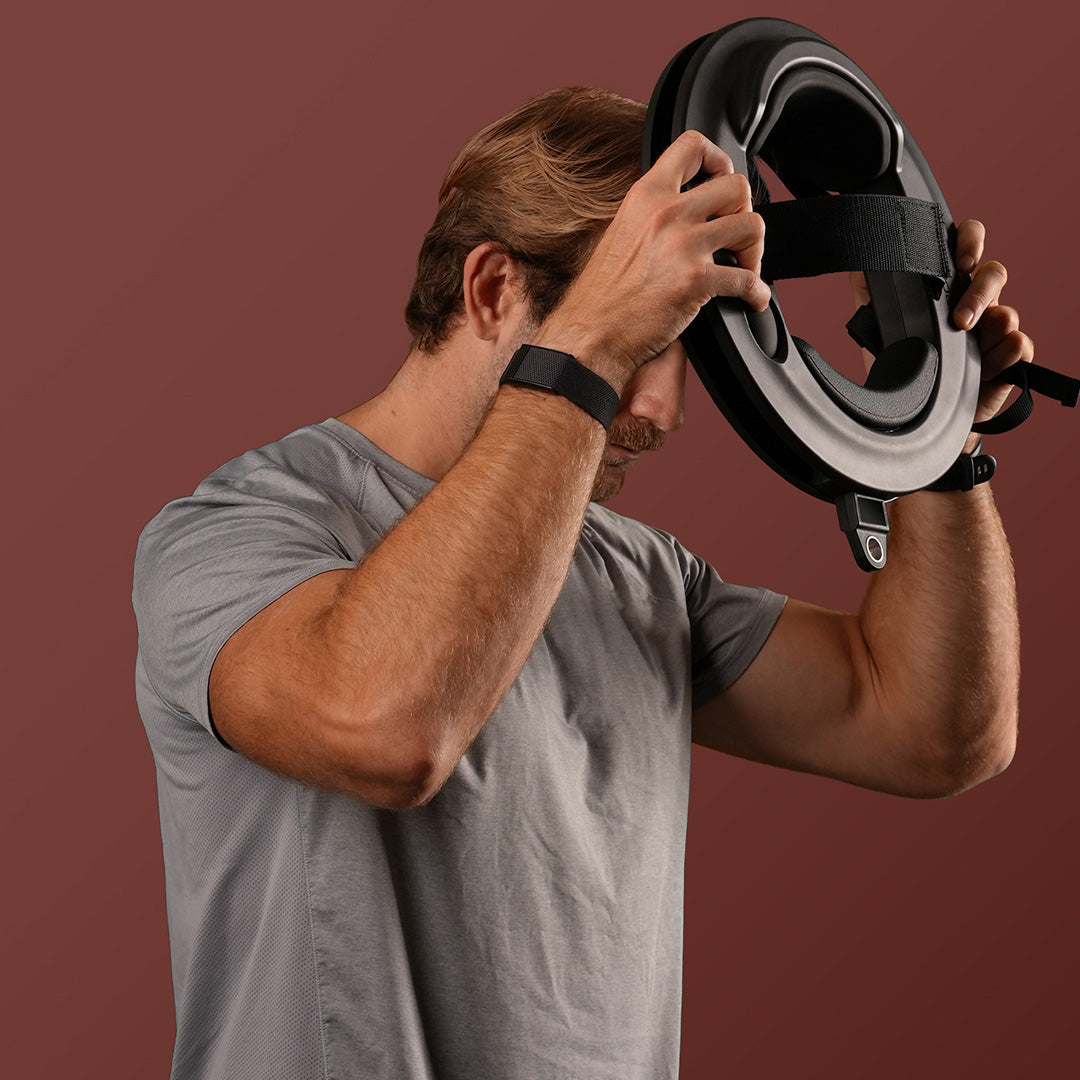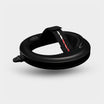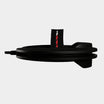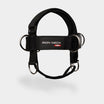Are you experiencing the whiplash effect? If you have ever had the severe neck pain that comes with this condition, you know that it can be debilitating. The slightest movement of your head or shoulders is almost impossible. Whiplash injuries are common and very painful, and they can result from several reasons, with the most common being motor vehicle accident-related.
That's why we're here to teach you how to prevent whiplash in the first place, saving a whole lot of pain, discomfort, and lost time in the future.
Every year, more than a million cases of whiplash injuries are reported in the United States alone. Almost half of this number suffers from the after-effects long after the injury occurred. What a shame - because there is so much you can do in terms of preventing whiplash. And below, we'll cover all these for you - including the best whiplash neck exercises and stretches.
Wait - you can prevent neck injuries like whiplash through neck training? Yep - and it's easier than you may have originally thought, too. You can do neck workouts at home with the right equipment. More on that later. First, let's open this conversation with a brief overview of whiplash injuries.
What is Whiplash Injury?
Whiplash is a neck injury, unfortunately often mistreated or ignored due to a lack of proper information on the injury. Whiplash is a neck injury caused by the neck being forcibly bent forward and backward or vice versa. Whiplash injury usually occurs from a rear impact while in a stationary position such as a car accident.
This forceful movement contracts and stretches the neck muscles, tendons, discs, and ligaments. When these connective tissues extend beyond their standard limits, they become strained or torn. This leads to painful soft tissue injuries such as Hyperextension or Hyperflexion. A common whiplash injury is sometimes called neck strain. It excludes dislocations or fractures of the cervical spine, head injuries, or unconsciousness.
Late or chronic whiplash syndrome refers to any symptoms that persist six months past the incident or accident. Whiplash injury emerged in 1928 in a lecture by an orthopedist called Crowe.
Before 1928, the condition ‘Railway spine’ described head and neck injuries in people involved in train accidents. Fortunately, whiplash is not fatal but sometimes leads to extended periods of limited disability. To keep such problems at bay, ensure you visit your doctor as soon as a whiplash injury occurs. Or better yet, keep reading as we discuss how to prevent whiplash in the first place. We’ll get to that after we cover some of the common symptoms of this injury:
Whiplash Injury Symptoms
The most common signs of whiplash injury include:
- Headache
- Neck and shoulder stiffness and pain
- Dizziness
- Fatigue
- Arm pain and weakness
- Temporomandibular joint symptoms (jaw pain)
- Tinnitus (ringing in ears)
- Back pain
- Blurred vision
- Irritability
- Low back pain
In chronic cases of a whiplash injury, symptoms may include:
- Depression
- Frustration
- Anxiety
- Stress
- Drug dependency
- Post-traumatic stress disorder
- Insomnia
- Bladder and bowel issues
Symptoms of whiplash from a rear-end collision can typically last a couple of months to several years after the accident. Following a treatment plan that consists of medication and whiplash exercises or physical therapy can reduce the whiplash injury duration to a few weeks. A severe case of a whiplash injury may lead to chronic pain in the neck and extending to the shoulders. If you leave whiplash untreated, it may lead to further neck injury and effects such as:
- Ringing in the ears
- Memory loss
- Problem concentrating
- Poor sleep
Whiplash Injury Diagnosis
If you experience these symptoms, you need to see a doctor to get a proper diagnosis and appropriate treatment plan. After an accident, the doctor examines the patient to rule out any injuries that require immediate treatment. Based on the examination and exhibited symptoms, the doctor may recommend a cervical collar for extra neck support.
A doctor may recommend neck X-rays to rule out fractures of the neck, head, and other bones in the body. If the X-rays come back standard, and yet you still have neck pains, the doctor may even decide to have you stay with the cervical collar, but ask you to come back in a week for an evaluation.
The doctor may choose to ask for further X-rays, and if the doctor is worried about soft tissue injury, he/she may take X-rays with your head leaning both forward and backward. X-rays consist of electromagnetic energy beams that produce images, bones, organs, and internal tissues.
The doctor may then recommend:
- MRI (Magnetic resonance imaging: a computer and large magnets make incredibly detailed images of your soft tissue structures and organs in your body.
- CT (Computed Tomography) scan: X-rays and advanced computer technology make axial or horizontal images of your body, mostly known as slices. A CT scan reveals detailed images of whichever part of the body and included muscles, fat, organs, and bones. A CT scan shows more detail than a general X-ray.
- Discography: This is an injection into the disc to find out if a disc is contributing to back pain. Discography is done for patients with chronic pain that has not improved over time, and for patients whom surgery is an option.
- Electromyography and Nerve conduction velocity (EMG/NCV): This treatment is used if the doctor suspects a nerve is trapped, or your nerves are damaged.
How to Treat Whiplash Injury
While learning how to prevent whiplash in the first place is a better approach, it may be too late for you. If you’re already suffering from this condition, there are several ways you can treat whiplash injury. Let’s start with using whiplash neck exercises:
Body Mechanics and Strength Training
Whiplash injury treatment in the first several weeks and months comprises whiplash therapy via body mechanics instruction and strength training.
People who improve after 12 weeks need specialized treatment from spine specialists. Strength training is crucial in developing enough strength to enable you to hold the neck and head at proper postures during both rest and activity. Strengthening your muscles (internal link?) allows you to improve their motion range.
Body mechanics is, in essence, the way the head, neck, torso, and lower back interrelate at rest and during movement. When you train on proper posture, you decrease vertebrae, disc, and muscle stress, allowing any damaged tissue space to heal. Poor body mechanics and posture causes spinal imbalance and a lot of pressure to your neck, which slows down healing.
We’ll recommend some specific whiplash neck exercises below, but we want to finish off the rest of the treatment options you have at your disposal.
Medication
Medication is crucial for controlling symptoms of a whiplash injury. As much as they do not solve the issue, they are a significant part of the treatment plan. There is no best or specific neck pain medication. The medication choice depends on the neck pain type, the severity, the pain duration, and the patient’s condition.
Some examples of medicine often prescribed for chronic neck pain include narcotic (opioid) pain relievers or anti-inflammatory drugs. Your doctor may also prescribe some muscle relaxants. For acute neck pain, antidepressants and opioid analgesics may be prescribed.
Spinal Injections
Spinal injections may help with specific patients. Injections, just like medication, do not cure. Instead, they are part of a whole treatment plan. Epidural injections administered to the spinal canal provide temporary relief in nerve compression cases where there is arm pain.
Radiofrequency neurotomy (RFN) helps by heating the nerves to prevent them from sending pain signals and helps with facet joint pains. It is useful for at least 9 to eighteen months, then re-administered if necessary. The doctor should only administer this method for chronic pain.
Spinal Manipulative Therapy
Specially trained therapists, osteopaths, and chiropractors usually administer spinal manipulative therapy (SMT). SMT provides many people with symptom relief and is very safe. This whiplash therapy needs to be combined with body mechanics instruction and strength training.
Surgery
When it comes to chronic neck pain, surgery is rarely necessary. It becomes the last resort when severe pain arises from either one or two discs. If the patient is healthy psychologically, disabled and has not improved with non-operative treatment plans. Surgery happens when there is pressure in the spinal cord or nerve.
How To Prevent Whiplash in the First Place
Now you know all about treating this injury if it occurs…but you came here to learn how to prevent whiplash in the first place to avoid all this. And that’s exactly what we’ll cover next.
The best way to prevent whiplash injury from sports is to carry out whiplash exercises and using appropriate protective gear, especially during contact sports. The neck absorbs shock from the head to the body, and vice versa, and a stronger neck reduces the amount of force transferred to your head during a whiplash injury. Not all contact sports have in-game protective gear, but if you can take advantage of it when available, the better.
Contact sports cannot be 100% whiplash injury-proof, but adding neck training to your routine can help reduce the risk of injury. The best whiplash exercises are performed using neck strengthening equipment such as the Iron Neck.
But perhaps the best way to prevent whiplash is through whiplash neck exercises. We know that a stronger neck is more resistant to injuries like concussions - which are often a result of whiplash. We talk more about this in our complete guide on how to prevent concussions. But how exactly does neck training prevent whiplash?
Strong neck muscles are better able to support and stabilize the head and neck during sudden movements, such as those that occur during whiplash. This can help to reduce the amount of stress placed on the neck muscles and ligaments, decreasing the likelihood of injury.
Moreover, neck training improves your posture. Poor posture can place extra strain on the neck and increase the risk of injury during sudden movements. Strengthening the muscles that support good posture, including those in the neck, can help to reduce this strain and prevent injury. We have a complete guide on exercises for neck posture if you’d like to learn more. But, that’s not all.
You can also undertake neck flexibility exercises. Maintaining flexibility in the neck muscles and ligaments can help to improve range of motion and reduce the risk of injury during sudden movements. Regular stretching and whiplash exercises can help to improve flexibility and protect against whiplash.
And, the benefits of neck exercises aren't just limited to injury prevention. You'll enjoy a host of other benefits - like less neck pain, better mobility, better performance in sports, and a better appearance through proper neck posture. What more could you ask for in a whiplash prevention tactic?! We'll let you in on some of the best whiplash neck exercises below.
The Best Whiplash Neck Exercises for Prevention & Treatment
Most cases of whiplash injury resolve in three weeks following appropriate treatment. Other remedies include neck stretches that you can carry out with a therapist, or at home. But if you want to speed up your recovery timeline - or even prevent cervical whiplash in the first place - you can work to overcome neck weakness once and for all.
Some simple whiplash neck exercises can become more effective with Iron Neck - the best neck exercise equipment on the market. It unlocks 360-degree training so you can attack your neck muscles from all angles. It's undoubtedly the most effective piece of equipment for neck exercises and will help you make concerns over whiplash injuries a thing of the past. Otherwise, you can consider a traditional neck workout harness.
Once you have your equipment, here are the whiplash neck exercises we recommend:
Chin Tucks or Protraction-Retraction
These whiplash exercises stretch your neck and upper back muscles. Squeeze your shoulder blades together and pull your head back slowly while tucking in your chin.
When using Iron Neck, carry out this whiplash exercise facing to and away from the anchor point. Iron Neck is equipment designed to strengthen the neck in a safe, controlled and effective manner.
Neck Rotation or Look Left Look Right
Neck exercises that involve rotating movements improve the ability to turn your head without pain and discomfort. Rotate your head slowly to either side until you feel a stretch on the opposite side.
Neck training allows you to improve your rotational strength by using smooth, resistance band training around the head. In certain Iron Neck models, you can add rotational friction to increase concentric training.
Side Bending / 360 Spin / Diagonals
This neck stretch improves your side-to-side motion. Drop your right ear slowly towards your right shoulder. Repeat this towards the left shoulder.
This 360-degree spin isometrically engages all the sides of the neck and helps identify tender spots as you perform clockwise and counterclockwise rotations. Doing a diagonal adds some mobility to the conventional side-bending exercise.
For oblique exercises, face to and away from the anchor point, both right and left, engaging either neck side.
Parting Thoughts on How to Prevent Whiplash Through Exercise
Whiplash injury can happen to anyone and occurs typically via rear-end collisions or contact sports. Once you get into a rear-end collision, no matter how low speed, ensure you see a doctor. Whiplash may take hours or days to manifest, and if not taken care of, can lead to severe issues.
A doctor will gauge how severe your injury is and treat you accordingly. If the whiplash injury is not very serious, simple exercises like the chin tuck or side bending will take care of your neck mobility issues. As a contact sportsperson, neck-strengthening activities will ensure your neck can take the pressure of continuous jarring.
Want to learn more about how to get a thicker neck? Our blog as a plethora of helpful resources. Learn all about the best neck exercise for mass, how to build neck muscles at home, neck training before and after results to expect, and more.
Now that you know how to prevent whiplash by using the top whiplash neck injuries, get to work so you can keep living your life pain-free and without limits!











